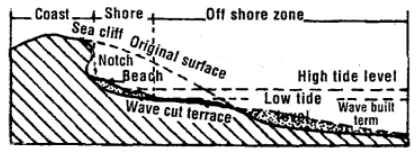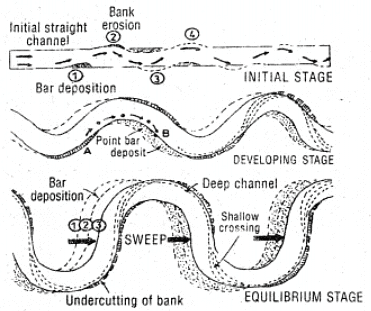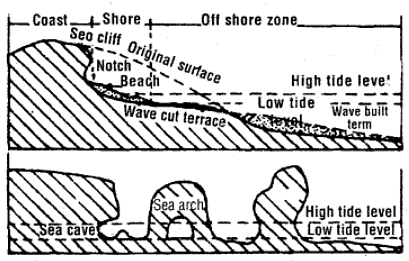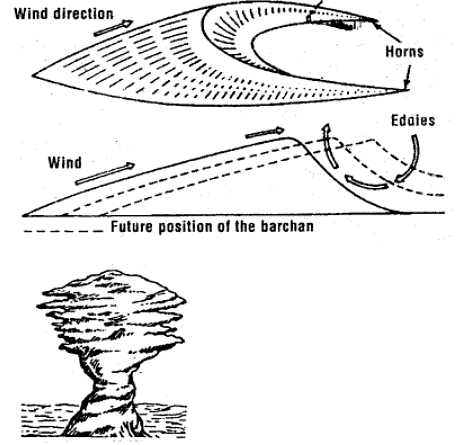Important Questions: Landforms & their Evolution | Geography Class 11 - Humanities/Arts PDF Download
Very Short Answer Type Questions
Q1: What is the relief?
Ans: The physical landscape of the earth’s surface is called relief. It includes mountains, valleys, plains, and plateaus.
Q2: Arrange the following from smaller to bigger form: stream, gully, river, rill.
Ans: Rill, gully, stream, river.
Q3: What is a landform?
Ans: The landform is the shape, focus and volume of a specific physical feature of the earth’s surface produced by natural processes of erosion and deposition.
Q4: Name two basic forms in which the running water acts as a geomorphic agent.
Ans: As a geomorphic agent, the running water acts in two basic forms, namely overland flow and channel or streamflow.
Q5: What are three closely inter-related geomorphic works performed by rivers?
Ans: Rivers perform three closely inter-related geomorphic works, viz., erosion, transportation, and deposition.
Q6: What is Karst topography?
Ans: Karst topography is a landscape formed by groundwater in a limestond region.
Q7: Why is wind action most prominent in arid and semi-arid areas?
Ans: Wind action is strongest in arid and semi-arid regions due to loose soil, minimal vegetation, and dry conditions. These factors allow wind to erode, transport, and deposit materials freely, shaping the landscape significantly.
Short Answer Type Questions
Q8: What are snowfields? Where are they generally situated?
Ans: Snowfields are large areas that are permanently covered with snow and ice. They are typically found:
- Above the snow line
- In high mountain regions
Q9: Write a short note on the formation of sand dunes.
Ans: Sand dunes form when wind deposits sand that it carries. Key features of sand dunes include:
- Barchans: Crescent-shaped dunes with points facing away from the wind, forming in areas with constant, moderate winds and a uniform surface.
- Parabolic dunes: These are reversed barchans that occur where sandy surfaces are partially covered with vegetation.
- Seif dunes: Long, narrow dunes with a single wing, formed when wind conditions change.
- Longitudinal dunes: Formed when sand supply is low and winds are consistent, appearing as long ridges.
In dry, hot deserts, the presence of obstacles is crucial for dune formation. The wind's ability to sort grains effectively contributes to the development of various dune shapes.
Q10: What is a fiord?
Ans: A fiord is a deep, steep-sided water inlet created when a glacial trough near the sea fills with seawater. Key characteristics include:
- Typically found along the coasts of Norway and Chile.
- Formed by the melting of glaciers.
- Features steep cliffs on either side.
Q11: Define fluvial denudation.
Ans: Fluvial denudation refers to the process of land degradation caused by running water. It is a key factor in shaping the Earth's surface, particularly in humid regions. The main points include:
- Running water is the primary agent of denudation, transporting excess rainfall from land to oceans.
- It works through stream action, which, combined with weathering and mass wasting, leads to erosion.
- There are two forms of water flow: overland flow (sheet erosion) and linear flow (streams and rivers).
- Over time, streams erode landscapes, creating valleys and altering landforms.
Q12: Discuss the features developed due to falling rain on bare surfaces.
Ans: Features developed due to falling rain on bare surfaces:
- Gentle rain loosens the soil and creates muddy water.
- This muddy water flows as a thin layer known as sheet flow.
- As the slope increases, water erodes sediments, forming small channels called rills.
- Rills undergo headward erosion, widening into gullies.
- Gullies dissect the land, leading to the formation of badland topography.
Q 13 ; How are lagoons formed? Give two examples of lagoons from India.
Ans: Lagoon are formed when sand bars along the coast cut off a portion of the sea from the main water body. Example:
- Chilka lake (in Orissa),
- Pulicat lake (Tamilnadu)."
Q14: Discuss features created by wave action.
Ans: At the shoreline, the line along which the water meets the land, the major erosive agent is wave action. Along the coast of hard rock, a gently inclined rock surface is carved out to accommodate the swash and backwash. It is called abrasion platform. A shoreline rising abruptly from the abrasion platform is called a marine cliff. The stormy waves thrust rock fragments with great violence against the cliff base to develop wave-cut notches or sea-caves. Relatively thick and gently sloping accumulation of sand, gravel or cobbles in the zone of breakers and surf is called beads.

Long Answer Type Questions
Q15: Write an essay on the geomorphic work of rivers,
Ans: Rivers are key agents of geomorphic change, shaping the landscape through erosion, transportation, and deposition. Starting from their source in mountainous areas, rivers gradually reshape the earth’s surface as they move toward their mouth, where they meet seas or oceans.
Erosion by Rivers
In the early stages, rivers flow rapidly over steep gradients, leading to intense vertical erosion. This erodes the bedrock and forms deep V-shaped valleys. As rivers mature and flow over gentler gradients, lateral erosion becomes more dominant, leading to the formation of wider valleys, meanders, and floodplains.
Transportation of Materials
Rivers carry a wide variety of materials, from fine sediments to larger rocks, depending on their speed and flow volume. In the upper reaches, rivers transport coarser materials, such as boulders, while in lower regions, they carry finer particles like sand and silt.
Deposition by Rivers
As rivers lose speed, particularly in flatter areas, they deposit the materials they carry. In the lower course, this leads to the formation of natural levees, point bars, and oxbow lakes. When rivers enter a body of water, like the sea, the reduction in speed causes sediment to accumulate, forming deltas.
Landforms Created by Rivers
Rivers create various landforms through their geomorphic work, including:
- V-shaped Valleys: Formed in the youthful stage due to vertical erosion.
- Gorges and Canyons: Deep valleys formed in mountainous regions due to erosion.
- Floodplains: Wide, flat areas created through sediment deposition during floods.
- Meanders: Curving paths formed by lateral erosion in the mature stage.
- Oxbow Lakes: Crescent-shaped lakes formed when meanders are cut off from the main river.
- Deltas: Triangular landforms formed by sediment deposition when rivers meet the sea.
Thus, rivers significantly shape the earth’s surface by eroding, transporting, and depositing materials. Their work creates diverse landforms such as valleys, floodplains, and deltas. This geomorphic process is essential for the formation of fertile land and ecosystems, making rivers vital to both the environment and human civilization.

Q16: Which is the most important agent modifying the coastal topography? Describe the various features formed by this agent of gradation.
Ans: The most important agent modifying coastal topography is sea waves. Sea waves erode, transport and deposit debris in the coastal regions and form both erosional as well as depositional features,
Erosional Features: Arches and Sea stacks: If the rock formation along the coast differs in resistance, softer rocks are eroded and harder remain to stand. This results in the formation of arches and stacks.
Depositional Features:
- Sea waves deposit sand, gravel and pebbles on the shore. These deposits are called beaches. Marine beach (Triplicane) in Chennai is famous in India.
- Sometimes sea waves deposit embankments of sand and gravel on the seafloor not far from the coast. These embankments are termed as bars. Very often ships strike against these bars and cause damage to themselves.
- Sometimes sand bars separate a portion of the sea from the main sea, giving birth to a lake lagoon. A lagoon is a saltwater .lake. These lakes have a connection with the main sea through sand and gravel along with the narrow outlets. Malabar coast in India abounds in lagoons. On the eastern coast, Chilka (in Orissa) and Pullicat (near Chennai) are two well-known lagoons.

Q17: How does wind affect rocks and what kinds of rocks are eroded the fastest? Explain the formation of landforms by winds.
Ans: Winds are not strong enough to remove the mineral matter from hard rocks, moist clay or soil rich in vegetation. They can only affect those rocks which are soft, arid and vegetation less. Hence rocks which are soft are eroded the fastest.
- Formation of landforms by winds: Winds form landforms both during erosional and depositional work.
- Erosional landforms: Winds erode loose particles of soil and take them away. In course of a time, a hollow is formed in the desert surface. This is called a wind-eroded basin.
- Depositional landforms: When the wind becomes weak and some obstacle lies in its path, deposition of transported loose particles begin to take place. Wind becomes weak due to the decrease in its velocity. As a result of the depositions, sand dunes are formed. They are of different types and shapes.

Q18: Distinguish between:
(i) V-shaped valley and U-shaped valley.
Ans: V-shaped valley: V-shaped valleys are typically found in areas with fast-flowing rivers and streams. They are characterized by steep, narrow sides and a narrow bottom. V-shaped valleys are formed primarily by the erosive action of running water, cutting down into the landscape over time.
U-shaped valley: U-shaped valleys, also known as glacial valleys, are formed by glaciers. They have a characteristic U shape, with steep sides and a broad, flat bottom. Glaciers, as they move, erode the landscape, carving out these U-shaped valleys. The distinctive U shape is a result of the grinding action of the glacier as it moves, scraping and shaping the valley floor and walls.
(ii) Valley glacier and Continental glacier.
Ans: Valley glacier: Valley glaciers are glaciers that form in mountainous regions and flow down valleys. They are long, narrow glaciers that move downhill through valleys, shaping the landscape as they go. Valley glaciers are typically found in high-altitude areas and are often surrounded by mountains.
Continental glacier: Continental glaciers, also known as ice sheets, are vast ice masses that cover large areas of continents. Unlike valley glaciers, which are confined to valleys, continental glaciers spread out horizontally, covering vast portions of the land beneath them. The most well-known examples of continental glaciers are the ice sheets in Antarctica and Greenland.
(iii) Gorge and Canyon.
Ans: Gorge: A gorge is a narrow, steep-sided valley with a river or stream flowing through it. Gorges are often characterized by cliffs or high, rocky walls. They are typically formed by the erosive action of rivers cutting through rock over millions of years. Gorges can be deep and dramatic, creating stunning natural landscapes.
Canyon: A canyon is a deep, narrow valley with steep sides, often with a river or stream flowing through the bottom. Canyons are broader than gorges and are usually the result of various geological processes, including erosion by rivers, wind, or glaciers. Canyons can vary widely in size, from small and picturesque to large and grand, such as the Grand Canyon in the United States.
Q19: Discuss the internal and external forces involved in the creation of landforms.
Ans: Landforms on Earth's surface are the result of a combination of internal and external forces acting over geological time scales. These forces shape the landscape through various processes. Let's explore the internal and external forces involved in the creation of landforms:
Internal Forces
1. Tectonic Forces:
- Plate Tectonics: The movement and interaction of Earth's lithospheric plates lead to the creation of various landforms. When plates collide, they can form mountain ranges (e.g., Himalayas). When they pull apart, they create rift valleys (e.g., East African Rift). Subduction zones, where one plate is forced beneath another, lead to the formation of deep ocean trenches and volcanic arcs.
- Earthquakes: Sudden movements along faults due to tectonic forces can cause earthquakes, which can create fault lines and influence the topography.
- Volcanism: The eruption of molten rock (magma) onto the Earth's surface leads to the formation of volcanoes and volcanic landscapes. Over time, repeated volcanic activity can build mountains and alter the land significantly.
2. Endogenic Processes:
- Diastrophism: Diastrophism refers to the deformation of Earth's crust, leading to the creation of various landforms. This can occur through processes like folding, faulting, and uplift.
- Volcanism: The eruption of lava and ash from volcanoes creates new landforms, including mountains, lava plateaus, and volcanic islands.
External Forces:
1. Erosion:
- Water Erosion: Rivers, streams, and rainfall erode the land, creating features such as valleys, canyons, and river deltas. Water also transports sediments, reshaping landscapes.
- Wind Erosion: Wind can erode softer rocks and create features like sand dunes and rock pedestals in deserts and arid regions.
- Glacial Erosion: Glaciers, massive sheets of ice, erode the land by plucking and abrasion. Glacial erosion forms U-shaped valleys, fjords, and other distinctive features.
2. Deposition:
- River Deposition: When rivers slow down, they deposit sediments, forming features such as riverbanks, floodplains, and alluvial fans.
- Glacial Deposition: Melting glaciers deposit sediments, creating landforms like moraines, drumlins, and eskers.
- Wind Deposition: Wind can deposit sand and dust, forming dunes, sandbars, and loess deposits.
3. Weathering:
- Physical Weathering: Processes like freeze-thaw cycles, pressure release, and abrasion break down rocks into smaller particles, contributing to the formation of soil and sediments.
- Chemical Weathering: Chemical reactions dissolve minerals in rocks, altering their composition. Acid rain, water, and organic acids are common agents of chemical weathering.
4. Biological Activity:
- Plant Roots: Plant roots can break apart rocks, contributing to physical weathering. Plants also produce organic acids, enhancing chemical weathering.
- Burrowing Organisms: Animals like earthworms and insects burrow into the soil, aiding in the mixing of organic material and minerals, promoting soil development.
Q 20 : Explain the different stages of a river.
Ans : A river passes through three stages like a human being: youth, mature, and old.
Youth Stage: Youth streams are less in number. In this stage, with poor integration and flow over original slopes, the river shows shallow V-shaped valleys with no floodplains or with very narrow floodplains along trunk streams. Stream divides are broad and flat with marshes, swamps, and lakes. If meanders are present, they develop over these broad upland surfaces. These meanders may eventually entrench themselves into the uplands. Waterfalls and rapids may exist where local hard rock bodies are exposed.
Mature Stage: During this stage, streams are plentiful with good integration. The valleys are still V-shaped but deep; trunk streams are broad enough to have wider floodplains within which streams may flow in meanders confined within the valley. The flat and broad inter-stream areas and swamps and marshes of youth disappear, and the stream divides turn sharp. Waterfalls and rapids disappear.
Old Stage: Smaller tributaries during old age are few with gentle gradients. Streams meander freely over vast floodplains showing natural levees, oxbow lakes, etc. Divides are flat and flat with lakes, swamps, and marshes. Most of the landscape is at or slightly above sea level.
|
70 videos|289 docs|44 tests
|
FAQs on Important Questions: Landforms & their Evolution - Geography Class 11 - Humanities/Arts
| 1. What are the different types of landforms found on Earth? |  |
| 2. How do tectonic activities influence the formation of landforms? |  |
| 3. What role does erosion play in landform evolution? |  |
| 4. How do climatic conditions affect landform development? |  |
| 5. Can human activities impact landforms? If so, how? |  |





















